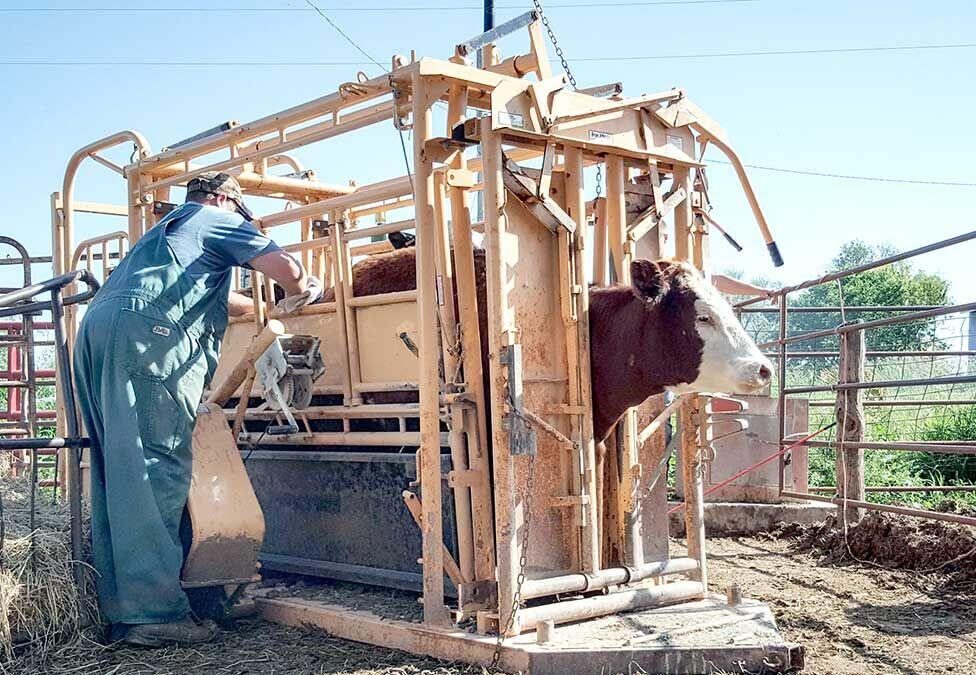Even a Small Needle Can Cause Big Problems

by Brandi Janssen
This morning, I picked up a batch of newly hatched broiler chicks from our post office. As I transferred them into their brooder, dunking each beak to make sure they got a good drink, I appreciated the fact that they had already received their Marek’s Disease vaccine at the hatchery.
Marek’s vaccine is typically administered as a subcutaneous injection. I am pretty certain that I would end up with more needles stuck in my fingers than in the chicks if I tried to vaccinate the wiggly little guys myself.
Giving injections is a standard procedure in livestock management that comes with some risk. The Upper Midwest Agricultural Safety and Health Center (UMASH), located at the University of Minnesota, reports that more than 80% of livestock workers have accidentally stuck themselves with a syringe when giving routine injections.
Vaccines are the most common type of product involved in these incidents.
Fortunately, most needle-stick injuries are minor. Even so, they may result in unpleasant effects.
Keep in mind that a needle that has been used to inject a horse, cow, sheep or pig will carry hair, dander, skin fragments and likely fecal material. These can contribute to a skin infection, one of the most common injuries following a needle stick.
Allergic reactions, either to the organic matter on the needle or to the product that was being injected, can also occur. If you are allergic to the product injected, such as an antibiotic, you could have a severe reaction. Sometimes, a needle stick can result in a deep tissue wound severe enough that it requires medical intervention.
In rare cases, needle stick injuries can be catastrophic, resulting in major injury or death. This is usually a result of the pharmaceutical being used. Tilmicosin (brand name Micotil), which is used to treat respiratory disease in cattle, can be extremely hazardous to humans, even in very small doses. In 2016, an Iowa man died from cardiac arrest just a few hours after an accidental injection of Micotil. The exact injection dose is unknown, but it was likely less than 5cc.
Other products to be aware of include Zylazine, a sedative that can induce a coma, and injected hormones that can cause spontaneous miscarriage in pregnant women. In addition, live vaccines, such as Bucella abortus Strain RB51 and Johne’s disease vaccine, can cause illness in humans.
There are retractable and hinge-capped needles available, but needle stick prevention relies heavily on good needle handling behaviors and livestock restraint.
Workers administering medications should work slowly and deliberately. Needles should not be re-capped, as this exposes the capping hand to the end of the needle. Never put the syringe or a needle in your pocket, regardless of whether or not it is capped.
After multiple uses, a needle degrades and may become bent. Do not try to straighten it. Instead, dispose of the needle and start with a new one.
According to Dr. Jeff Bender, professor of Veterinary Public Health at the University of Minnesota, more than half of needle-stick injuries actually occur after the injection or during needle disposal. Needles should never be disposed of individually in a trash receptacle. Instead, provide a sharps container. You can purchase these or simply repurpose any hard-sided plastic container that has a lid. A laundry detergent jug works well, or a cat litter bucket with a small opening cut in the lid.
After the container is full, it can be sealed and put in the regular trash.
The second component of needle stick is proper animal restraint. Techniques will obviously vary depending on the species and size.
The animal should be prevented from making any sudden movements, particularly with their head or neck since many injections are given in the back of the neck or behind the ear.
Small pigs can be restrained with a sling or snare. They can also be held firmly with one arm wrapped around the legs and the other hand grasping the snout. This requires a second person to administer the injection.
Cattle can be restrained in a stanchion with a halter and rope or in a squeeze chute with a head gate.
Finally, make sure you are using the appropriate syringe and needle for the job. Syringe selection will depend on whether the injection is intramuscular or subcutaneous.
Needle size is dependent on the size of the animal and the viscosity of the solution that will be injected. For example, the Office of the University Veterinarian at Virginia Tech recommends a ½-inch 16 to 18 gauge needle for a pig up to 25kg.
Using the right needle for the task also reduces the chance of a broken needle, which can be catastrophic if it remains in the animal and is later present in the meat.
Appropriate vaccine and medication schedules are critical to animal health and safety. Don’t neglect your own safety when administering them; take the proper precautions so that you don’t get stuck!
Brandi Janssen, PhD, directs Iowa’s Center for Agricultural Safety and Health (I-CASH) at the University of Iowa College of Public Health.

